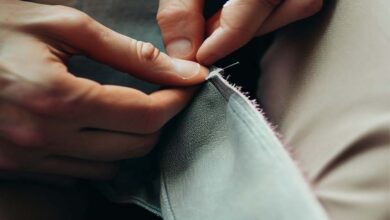How to Sew Slippery Fabric? Expert Tips and Tricks

Sewing is a delightful and rewarding hobby, allowing us to create beautiful garments and accessories. However, working with slippery fabrics can sometimes present challenges requiring specific techniques and extra patience.
Whether you are tackling satin, silk, rayon, or other slippery materials, learning how to sew slippery fabric effectively can make all the difference in achieving professional-looking results.
To sew slippery fabric, use a sharp needle and pins to secure the fabric in place while sewing. Additionally, reducing the pressure of foot tension can help prevent the fabric from slipping during the process.
However, In this article, we will explore various tips and techniques that will help you navigate the world of slippery fabrics confidently and efficiently.
What Are Slippery Fabrics?
Slippery fabrics refer to materials that have smooth and slippery surfaces, making them difficult to handle and sew. These fabrics often include silk, satin, chiffon, charmeuse, and rayon.
Slippery fabrics shift, slide, and fray easily, making them tricky to sew accurately and securely. These fabrics have a delicate and luxurious feel, which makes them highly sought after for elegant clothing and formal wear.
Types Of Slippery Fabric
Slippery fabrics are materials that have a smooth and slick surface, often allowing them to slide easily against other surfaces. These fabrics are commonly used in various applications, including clothing, upholstery, and sports gear.
Here are some types of slippery fabrics:
Silk:
Silk is a delicate and luxurious fabric known for its smooth texture and high sheen. It is prone to slipping and sliding, making it a bit tricky to sew.
Satin:
Satin is another popular choice for slippery fabric, with its glossy surface and soft feel. Its silky nature can make it challenging to handle, especially for beginners.
Chiffon:
Chiffon is a lightweight, sheer fabric commonly used for creating ethereal and flowy garments. Its delicate and slippery nature can pose difficulties when it comes to stitching.
Polyester:
Although polyester is not as luxurious as silk or satin, it can still present challenges due to its slippery finish.
It is a versatile fabric with various types, such as polyester satin or chiffon, which require special attention during the sewing process.
How To Sew Slippery Fabric?

Sewing slippery fabrics can be a bit challenging due to their tendency to shift and slide while working with them. However, you can achieve great results with the right techniques and tools.
Here are some tips on how to sew slippery fabrics:
Choose the Right Fabric:
Some slippery fabrics are more challenging to work with than others. Some examples of slippery fabrics are satin, silk, chiffon, and rayon. If you are a beginner, it might be best to start with a fabric that has a bit more stability, like cotton sateen or polyester satin.
Use a Sharp Needle:
Choose a fine, sharp needle appropriate for the fabric type. For lightweight fabrics, use a smaller needle size; for heavier slippery fabrics, use a larger needle size. A sharp needle will help prevent snags and create neater stitches.
Pin Strategically:
Instead of placing pins perpendicular to the fabric, try pinning parallel to the seam allowances. You can also use clips or fabric weights to hold the fabric pieces together.
Cut with Care:
Use sharp fabric scissors to cut the fabric, ensuring clean edges. If the fabric is prone to fraying, consider finishing the edges with a serger or a zigzag stitch on your sewing machine.
Test Stitch:
Before sewing your project, make a few test stitches on a scrap piece of the same fabric. Adjust the tension and stitch length until you get the desired results.
Stitch Length and Tension:
Set your sewing machine to a longer stitch length than you would use for regular fabrics. This will reduce puckering. Additionally, you may need to adjust the tension slightly. Again, testing on a scrap fabric is crucial.
Use Tissue Paper:
Placing tissue paper or a stabilizer between the fabric layers or under the fabric can help the fabric feed more smoothly through the machine.
Sew Slowly:
Take your time when sewing slippery fabrics. Sew slowly, guiding the fabric carefully to avoid bunching or stretching.
Hand Baste:
If the fabric is tough to manage, you can hand-baste the pieces together before sewing with the machine. Basting will help keep the fabric in place and provide better control.
Avoid Unpicking:
Seam ripping on slippery fabrics can leave noticeable marks. Take your time to ensure accurate sewing to avoid the need for unpicking.
Press with Caution:
Use a low heat setting on your iron or a pressing cloth to avoid damaging the fabric.
Remember that practice makes perfect. If you’re new to sewing with slippery fabrics, practicing on some scraps before working on your main project is a good idea. Over time, you’ll gain confidence and skill in handling these delicate materials.
For better visual understanding, watch the video.
How Do You Make Fabric Less Slippery?
Making fabric less slippery can be helpful for various purposes, such as improving the grip of clothing, preventing furniture covers from sliding, or enhancing the stability of specific sewing projects.
Here are some methods you can try to reduce the slipperiness of fabric:
- Fabric Spray or Liquid Grip: There are commercial fabric sprays or liquid grips available that you can apply to the fabric’s surface. These products create a tacky or sticky texture, which helps to reduce slipperiness. Follow the instructions provided on the product label for the best results.
- Non-Slip Fabric Liners: Non-slip fabric liners are specially designed mats or sheets that can be placed underneath the slippery fabric to increase friction and prevent sliding. These liners are commonly used in home projects, such as securing rugs on floors.
- Rubberized Grips or Dots: Sewing or gluing rubberized grips or dots onto the fabric can increase friction. These grips can be small rubber or silicone pieces attached strategically to the fabric’s surface.
- Fabric with Texture: Choosing a fabric with a textured surface can naturally reduce slipperiness. Fabrics like corduroy, velvet, or fabrics with raised patterns tend to have more grip than smooth, satin-like materials.
- Adding a Lining: Consider adding a lining to the slippery fabric if possible. The lining can be made of a material with more friction, which will help stabilize the main fabric.
- Tacking or Basting Stitches: Use temporary tacking or basting stitches to hold slippery fabric pieces together before permanent stitching. This can help prevent the fabric from shifting while you work on it.
- Iron-On Interfacing: Iron-on interfacing is a material that can be attached to the back of the fabric. It can add texture and stability to the fabric, reducing slipperiness.
What Are The Best Stitches For Slippery Fabric?

When working with slippery fabrics, using the right stitch is crucial to ensure that the seams are secure and the fabric doesn’t shift or pucker during sewing. Here are some stitches that work well with slippery fabrics:
Zigzag Stitch:
The zigzag stitch is a popular choice for slippery fabrics because it provides some flexibility and allows the fabric to move without breaking the stitches. It prevents the seams from popping when the fabric is stretched or pulled.
Straight Stitch with Tissue Paper:
A straight stitch can be combined with tissue paper for extremely slippery fabrics like silk or satin. Place a strip of tissue paper along the seamline and sew the fabric and tissue paper together.
Once the stitching is complete, gently tear away the tissue paper, leaving the seam secure.
Overlock or Serger Stitch:
If you have access to an overlock machine or serger, this type of stitch is excellent for finishing raw edges on slippery fabrics. It trims the fabric edges and encloses them with thread, providing a neat and secure finish.
French Seam:
French seams are ideal for delicate and sheer fabrics. They enclose the raw edges within the seam, giving a clean finish on both sides and preventing fraying. This type of seam is often used for lingerie and lightweight garments.
Hand Basting or Pinning:
Before sewing the final seam, you can use hand basting or carefully placed pins to hold the fabric pieces together temporarily. This helps keep the fabric in place during sewing, reducing slippage.
Tape or Fusible Interfacing:
Adding strips of lightweight tape or fusible interfacing along the seamline can stabilize the fabric and make it easier to sew. The tape or interfacing adds a bit of structure without adding bulk.
Walking Foot Attachment:
If your sewing machine has a walking foot attachment, use it for slippery fabrics. A walking foot helps to feed the fabric evenly through the machine, reducing the chances of stretching or bunching.
Always test your chosen stitch and settings on a scrap piece of the same fabric before sewing the final seam. This will allow you to adjust the tension, stitch length, and stitch type as needed for the specific slippery fabric you are working with.
Frequently Asked Questions On How To Sew Slippery Fabric?
What Type Of Needle Should I Use For Sewing Slippery Fabric?
When sewing slippery fabric, using the right needle is important to prevent snags or runs. A microtex or sharp needle with a smaller size, such as a size 70/10 or 80/12, is recommended. These needles have a fine point that can easily penetrate the fabric without causing damage.
How Can I Prevent Puckering When Sewing Slippery Fabric?
Preventing puckering in slippery fabric requires a few additional steps. Start by basting the fabric together with a long stitch length. You can also try using a thin strip of lightweight stabilizer along the seam line to provide extra support.
Finally, sew slowly and use a consistent tension setting to avoid uneven stitches that can cause puckering.
What’s The Best Stitch Length For Sewing Slippery Fabric?
When sewing slippery fabric, using a longer stitch length is generally advisable. A 2. 5 to 3mm stitch is a good starting point. A longer stitch length helps the fabric move smoothly under the presser foot without causing puckering or gathering.
Can I Use A Regular Sewing Machine Foot For Slippery Fabric?
While you can use a regular sewing machine foot for slippery fabric, it may not provide the best results. Consider using a walking foot or a Teflon foot instead. These specialty feet help the fabric feed evenly, reducing the chance of slippage.
They can make sewing slippery fabric much easier and produce better results.
Conclusion
Mastering the art of sewing slippery fabric requires practice, the right tools, and a thoughtful approach. By following the tips provided in this blog post, you can ensure that you are well-prepared to tackle even the most challenging fabrics.
Remember to choose the appropriate needle and thread, use sewing aids such as tissue paper or stabilizers, and adjust your machine settings accordingly.
Taking your time, using small stitches, and employing techniques like hand-basting will also go a long way in ensuring your success. Don’t be discouraged if you encounter difficulties at first—it takes time to develop the necessary skills.
With patience and persistence, you will become more confident in your ability to sew fabulous garments from even the slipperiest of fabrics.
Read More:



